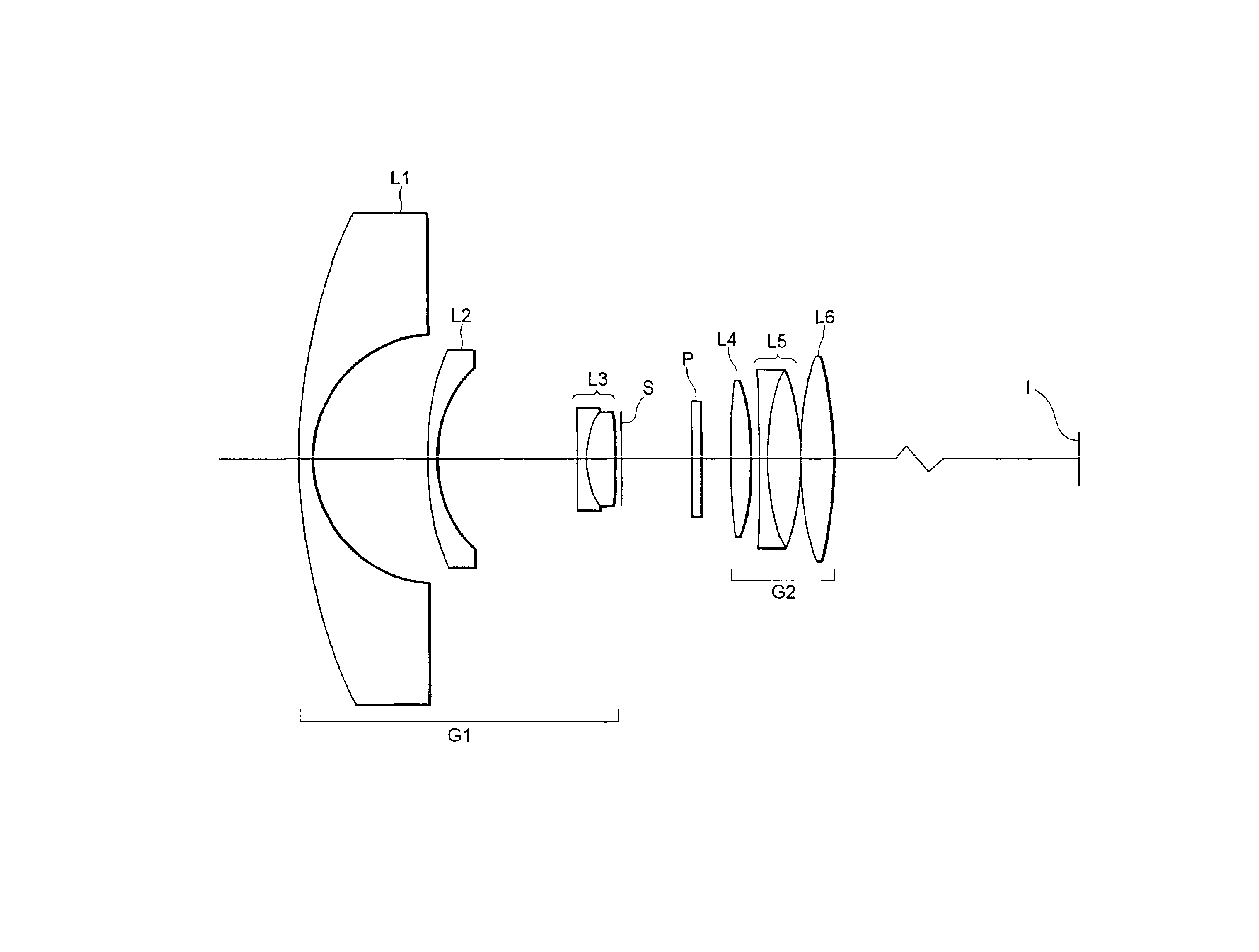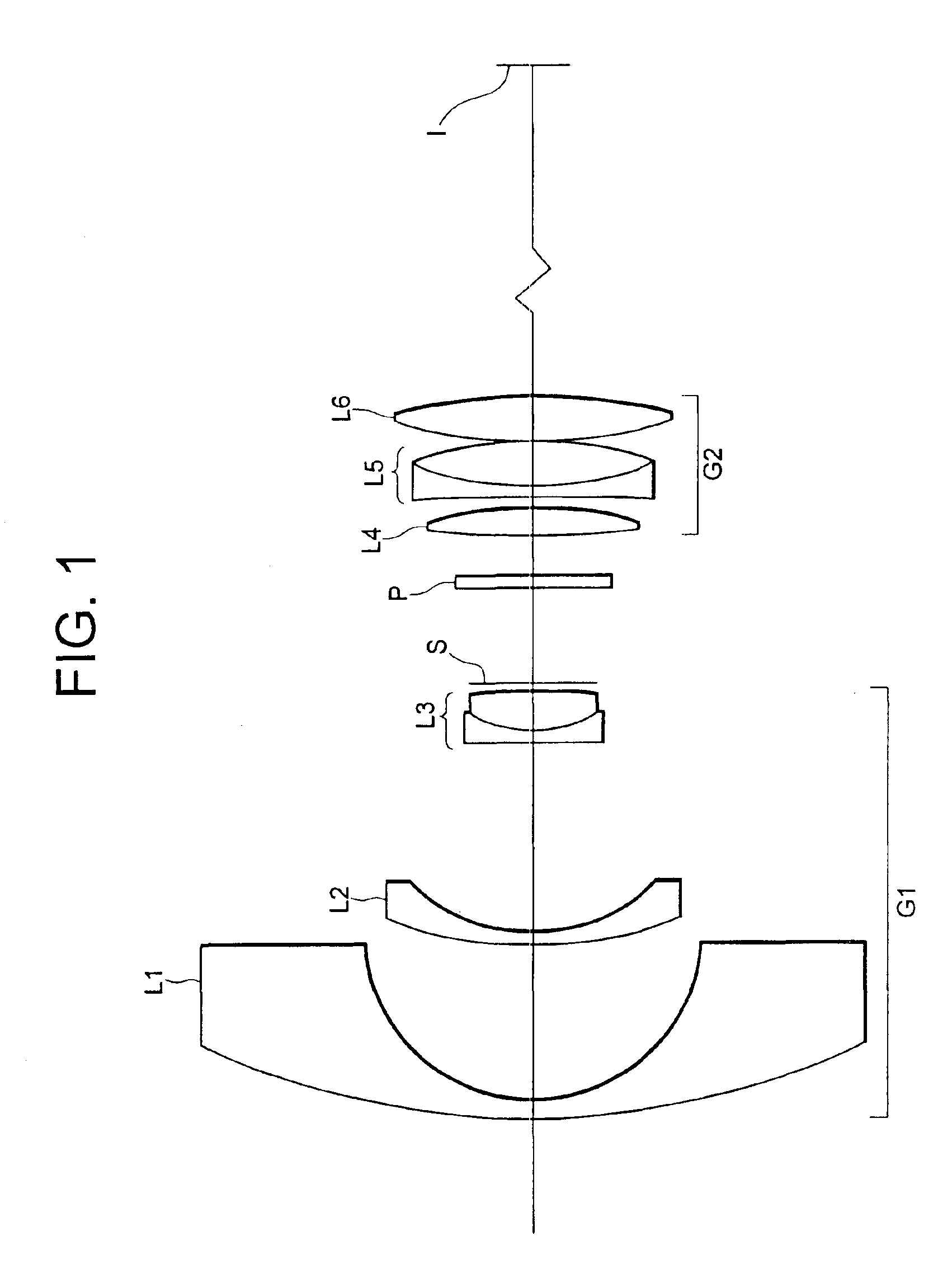Fisheye lens
a fisheye lens and lens body technology, applied in the field of fisheye lenses, can solve the problems of deteriorating optical performance, narrow angle of view of slr digital cameras whose image size is a little smaller than that of slr film cameras, and inability to secure 180 degree angle of view, etc., and achieve the effect of good curvature and superb optical performan
- Summary
- Abstract
- Description
- Claims
- Application Information
AI Technical Summary
Benefits of technology
Problems solved by technology
Method used
Image
Examples
first embodiment
A fisheye lens according to a first embodiment of the present invention is explained below.
A fisheye lens according to the first embodiment of the present invention consists of a front lens group having negative refractive power and a rear lens group having positive refractive power locating with a space along the optical axis apart from the front lens group. The front lens group includes a plurality of negative lens components. The rear lens group includes at least one cemented lens component.
The front lens group has a negative refractive power component having strong divergent effect to deflect light ray entering from a wide incident range of 180 degrees to a direction parallel to the optical axis. By constructing the negative refractive power component of the front lens group with a plurality of negative lens components, aberrations produced thereby can be spread to or shared by the plurality of the negative lens components.
In the first embodiment, the following conditional expre...
example 1
A fisheye lens according to Example 1 of the first embodiment shown in FIG. 1 consists of a front lens group G1 having negative refractive power, and a rear lens group G2 having positive refractive power arranged with a space along the optical axis apart from the front lens group G1. The front lens group G1 is composed of, in order from an object, a first lens component L1 having a negative meniscus shape with a convex surface toward the object, a second lens component L2 having a negative meniscus shape with a convex surface toward the object, and a third lens component L3 being a cemented positive lens component constructed by a negative lens element cemented with a positive lens element. The rear lens group G2 is composed of, in order from the object, a fourth lens component L4 having a double convex shape with a stronger convex surface facing to an image, a fifth lens component L5 being a cemented positive lens component constructed by a negative lens element cemented with a pos...
example 2
A fisheye lens according to Example 2 of the first embodiment shown in FIG. 3 consists of a front lens group G1 having negative refractive power, and a rear lens group G2 having positive refractive power arranged with a space along the optical axis apart from the front lens group G1. The front lens group G1 is composed of, in order from an object, a first lens component L1 having a negative meniscus shape with a convex surface toward the object, a second lens component L2 having a negative meniscus shape with a convex surface toward the object, a third lens component L3 having a double concave shape, and a fourth lens component L4 being a cemented positive lens component constructed by a positive lens element cemented with a negative lens element. The rear lens group G2 is composed of, in order from the object, a fifth lens component L5 having a positive meniscus shape with a stronger convex surface facing to an image, a sixth lens component L6 being a cemented negative lens compone...
PUM
 Login to View More
Login to View More Abstract
Description
Claims
Application Information
 Login to View More
Login to View More - R&D
- Intellectual Property
- Life Sciences
- Materials
- Tech Scout
- Unparalleled Data Quality
- Higher Quality Content
- 60% Fewer Hallucinations
Browse by: Latest US Patents, China's latest patents, Technical Efficacy Thesaurus, Application Domain, Technology Topic, Popular Technical Reports.
© 2025 PatSnap. All rights reserved.Legal|Privacy policy|Modern Slavery Act Transparency Statement|Sitemap|About US| Contact US: help@patsnap.com



